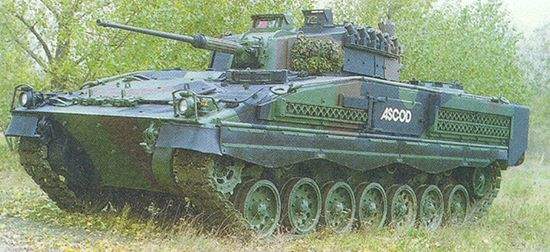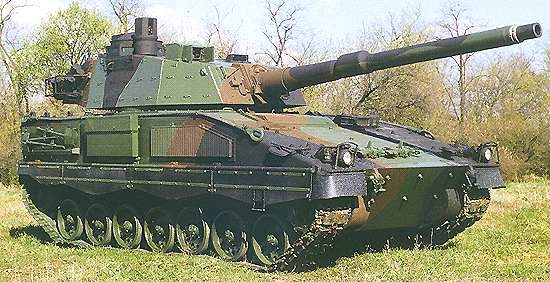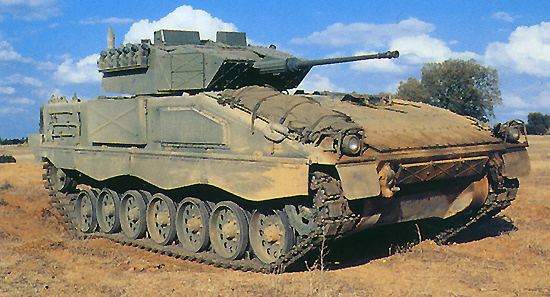
The ASCOD armoured fighting vehicle is named Pizarro in Spain and Ulan in Austria
The ASCOD (Austrian-Spanish Cooperative Development) family of fighting vehicles is marketed by ASCOD AIE with headquarters based in Madrid, Spain. ASCOD is a jointly owned company set up by Steyr-Daimler-Puch AG of Vienna, Austria and General Dynamics, Santa Barbara Sistemas (GDSBS) of Madrid, Spain. In November 2003, General Dynamics took over Steyr-Daimler-Puch; both companies now form General Dynamics European Land Systems (GDELS), along with MOWAG of Switzerland.
As well as the infantry fighting vehicle, the ASCOD family includes: LT 105 light tank, anti-aircraft missile carrier, anti-aircraft gun system, anti-tank guided missile carrier, mortar carrier, repair and recovery vehicle, logistics carrier, command and communication carrier, artillery observation post and ambulance.
ASCOD Pizarro / Ulan infantry fighting vehicle
The infantry fighting vehicle is in service with the Spanish Army where it is called the Pizarro and with the Austrian Army where it is known as the Ulan.
An initial 123 Pizarro infantry fighting vehicles and 23 command and communications vehicles were ordered in 1996 and delivered to the Spanish Army by the end of 2002.
A follow-on contract – for 106 IFVs, five command post vehicles, 28 forward observer vehicles, eight recovery vehicles and one combat engineer vehicle – was placed in January and signed in December 2003. An additional 80 vehicles was ordered in February 2008, to bring the total fleet to 374. Delivery of the second phase vehicles is planned for 2008–2013.
The second phase vehicles, Pizarro II, will have the same MTU Series 199 engine which was fitted on the Ulan, with a power output of 530kW.
112 Ulan vehicles were delivered to the Austrian Army between 2002–2005.
In June 2008, GDELS, in conjunction with KMW, announced Donar, a medium-weight 155 mm self-propelled artillery system based on the KMW PzH2000 artillery system integrated with the ASCOD 2 chassis. A prototype has begun mobility and firing trials in Germany.
Armament
Turret control is electro-mechanical and the turret is fitted with a turret drive stabilisation system from Curtiss-Wright Controls of Gastonia, North Carolina. The weapon system is stabilised in two axes, which allows the vehicle to engage targets stationary or on the move. Elevation is from -10° to +50° with a 360° traverse.
The vehicle’s main armament is a 30mm dual-feed, gas-operated Mauser mk30-2 automatic cannon with a 7.62mm coaxial machine gun. The 30mm gun has a rate of fire of 800 rounds a minute and can fire a range of ammunition including APFSDS rounds. The vehicle carries 200 rounds of 30mm and 700 rounds of 7.62mm ammunition ready to fire, and a store of up to 205 rounds of 30mm and up to 2,200 rounds of 7.62mm ammunition.
Self-protection
The hull and turret are constructed from all-welded steel armour, which provides protection against 14.5mm armour-piercing incendiary rounds over the forward 60° arc and all round protection against 7.62mm weapon attack.
Additional ballistic protection is available against up to 30mm APFDS (armour-piercing fin-stabilised discarding-sabot) rounds fired from a 1,000m range over the forward 60° arc, and all round protection against 14.5mm armour-piercing incendiary (API) rounds from a range of 500m.
Two sets of three smoke grenade launchers are installed on each side of the turret. ASCOD fighting vehicles can be fitted with laser warning system and NBC (nuclear, biological, chemical) detection system.
Fire control and observation
Spanish Pizarro vehicles are fitted with the mk10 fire control system from Indra (formerly Enosa), which provides shoot-on-the-move capability and 0.1 mil gun aiming. The mk10 has a full solution digital ballistic computer, day channel, thermal channel and laser rangefinder.
The first batch of 123 vehicles are fitted with the SVT-02 first-generation thermal imager. The mk10 has since been upgraded with a second-generation imager, the VC2, which will be fitted on subsequent vehicles. The VC2 thermal imager is based on a 240×4 detector array and operates in the 7.5 to 10.5 micron spectral band. It has wide field of view of 12.3°×7.7° and narrow FOV of 4.1°×2.6° (azimuth × elevation).
In November 2004, Indra was awarded a contract for upgrading the fire control system on the Pizarro. The programme includes upgrades to the stabilisation and aiming system and next-generation thermal imager.
Austrian Ulan vehicles are equipped with the Kollsman day / night range sight (DNRS) which has a digital computer, day channel and thermal imaging sight with an integrated laser rangefinder. The 8 to 12 micron thermal imager is dual field of view and has magnifications of ×2.8 and ×8.4. An automatic target tracker inputs targeting data to the line-of-sight servo system and into the turret drive.
The commander has a periscopic day sight, a television monitor displaying the image from the gunner’s thermal sight and six unity vision periscopes.
Propulsion
The ASCOD is fitted with an MTU 8V-183-TE22 8-V90 diesel engine, rated 600hp, and a Renk HSWL 106C hydro-mechanical transmission, and torsion bar suspension.
MTU has developed a new more powerful engine (530kW at 2,300rpm), the 8V 199, which will be fitted to Ulan vehicles.
LT 105 light tank
The LT 105 light tank has been selected by the Royal Thai Marine Corps which requires 15 tanks, plus one command and one recovery vehicle. It is fitted with a three-man turret such as the 105 low-recoil force turret by Oto Melara, General Dynamics low-profile turret or the LIW turret. The tanks for Thailand will have the LIW turret. Main armament is a 105mm semi-automatic low recoil tank gun with a 7.62mm coaxial machine gun.












